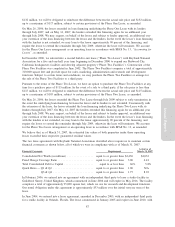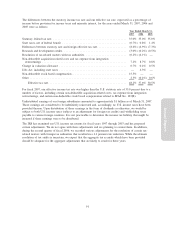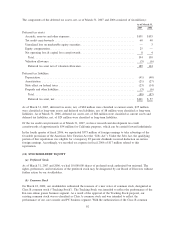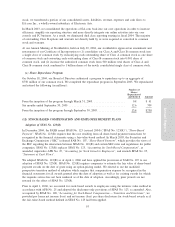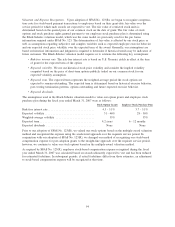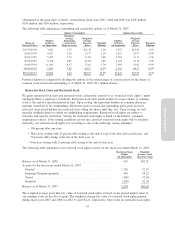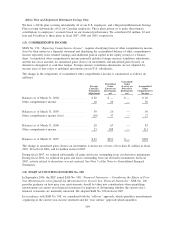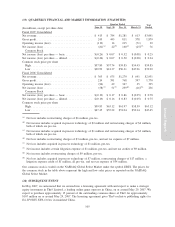Electronic Arts 2007 Annual Report Download - page 169
Download and view the complete annual report
Please find page 169 of the 2007 Electronic Arts annual report below. You can navigate through the pages in the report by either clicking on the pages listed below, or by using the keyword search tool below to find specific information within the annual report.
The following table summarizes stock-based compensation expense resulting from stock options, restricted
stock, restricted stock units and our employee stock purchase plan included in our Consolidated Statements of
Operations (in millions):
2007 2006 2005
Year Ended March 31,
Cost of goods sold ................................................... $ 2 $— $—
Marketing and sales .................................................. 17 — —
General and administrative ............................................. 37 1 —
Research and development ............................................. 77 2 6
Stock-based compensation expense ..................................... 133 3 6
Benefit from income taxes.............................................. (26) (1) (2)
Stock-based compensation expense, net of tax ............................. $107 $ 2 $ 4
As of March 31, 2007, our total unrecognized compensation cost related to stock options was $153 million
and is expected to be recognized over a weighted-average service period of 1.6 years. As of March 31, 2007,
our total unrecognized compensation cost related to restricted stock and restricted stock units was $82 million
and is expected to be recognized over a weighted-average service period of 2.3 years.
The adoption of SFAS No. 123(R), using the fair value method, had the following adverse impact on our pre-
tax income, net income, and basic and diluted net income per share as compared to what would have been
reported under APB No. 25 using the intrinsic value method, which was the method used prior to our adoption
for the year ended March 31, 2007 (in millions, except per share data):
Fair Value
Method
(As Reported)
Intrinsic
Value
Method
Adverse
Impact
of Change
Income before provision for income taxes and minority interest ........ $138 $237 $ (99)
Net income .............................................. $ 76 $153 $ (77)
Net income per share:
Basic ................................................. $0.25 $0.50 $(0.25)
Diluted ................................................ $0.24 $0.48 $(0.24)
APIC Pool. In November 2005, the FASB issued FASB Staff Position (“FSP”) No. Financial Accounting
Standard (“FAS”) 123(R)-3, “Transition Election Related to Accounting for the Tax Effects of Share-Based
Payment Awards”. The FASB allows for a practical exception in calculating the additional paid-in capital pool
(“APIC pool”) of excess tax benefits upon adoption that is available to absorb tax deficiencies recognized
subsequent to the adoption of SFAS No. 123(R). For employee stock-based compensation awards that are
outstanding upon adoption of SFAS No. 123(R), the alternative transition method provides a simplified method
to establish the beginning balance of the APIC pool related to the tax effects of employee stock-based
compensation. It also provides a simplified method to determine the subsequent impact on the APIC pool and
Consolidated Statements of Cash Flows for the tax effects of employee stock-based compensation awards. We
elected to adopt the alternative transition method provided in FSP No. FAS 123(R)-3 for calculating the tax
effects of stock-based compensation pursuant to SFAS No. 123(R).
Cash Flow Impact. Prior to our adoption of SFAS No. 123(R), cash retained as a result of tax deductions
relating to stock-based compensation was presented in operating cash flows along with other tax cash flows.
SFAS No. 123(R) requires a classification change in the statement of cash flows. As a result, tax benefits
relating to excess stock-based compensation deductions, which had been included in operating cash flow
activities, are now presented as financing cash flow activities (total cash flows remain unchanged). For the
fiscal year ended March 31, 2007, we recognized $34 million of tax benefit from the exercise of stock options;
of this amount, $36 million of excess tax benefit related to stock-based compensation reported in financing
activities. For the fiscal year ended March 31, 2006, we recognized $133 million of tax benefit from exercise
of stock options reported in operating activities.
Annual Report
95




